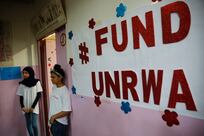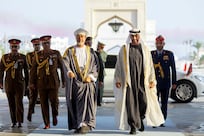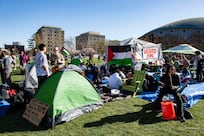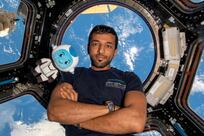Archaeological finds made on an island near the capital in 1959 proved pivotal in defining and promoting the UAE’s relics and antiquities. Sheikh Zayed, the nation’s Founding Father, was one of the first to spot their importance.
In the spring of 1959, the Ruler of Abu Dhabi at the time, Sheikh Shakhbut bin Sultan, made one of several visits to an island 20 kilometres from his ancestral home at Qasr Al Hosn, which we now know as Sas Al Nakheel but was then known as Umm an-Nar.
Rendered in the bleached tones that are now so redolent of the period, the event was captured in a photograph that not only acts as an evocative royal portrait but also represents a milestone in the history of archaeological exploration in the Emirates, which will be explored in The Archaeological Story of the United Arab Emirates – a public lecture on Wednesday evening at Manarat Al Saadiyat.
Although nobody quite realised it at the time, Umm an-Nar, which had become the site of the first archaeological excavation to be conducted in the Emirates, would produce crucial finds that would eventually give its name to a unique Bronze Age culture that now defines the archaeological record in the same way as sites such as Mycenae, La Tene and Harappa.
If the archaeological value of Umm an-Nar’s crumbling burial chambers was not immediately evident, the significance of the dig was not lost on Sheikh Shakhbut nor on his brother, Sheikh Zayed, the Founding President of the UAE who lived and served at the time as the Ruler’s Representative in Al Ain.
Not only would that first archaeological season at Umm an-Nar lead to a second, in 1960, which revealed evidence of a previously unknown ancient culture, but it also prompted Sheikh Zayed to invite the dig’s English and Danish archaeologists to explore the similar but far more numerous tombs that defined the escarpments, oases and valleys of the area then known as Buraimi.
“This is a period in which Sheikh Shakhbut and Sheikh Zayed both played critical roles in promoting archaeological research, when you had someone who was going to become leader who was very interested in promoting archaeology and understanding the history of this region.”
So says the archaeologist and academic Peter Magee, who, alongside Eisa Yousif, director of excavation and archaeological sites at the Sharjah Archaeology Authority, will present on Wednesday evening’s talk.
“But this was also a moment when archaeology had matured as a discipline and when the practice of going to countries throughout the Middle East and extracting large-scale antiquities and putting them in museums in western Europe had come to an end,” says Dr Magee.
As well as having worked on UAE excavations for 25 years, Dr Magee is also professor of classical and near eastern archaeology at Bryn Mawr College in Pennsylvania and now, as the recently appointed head of archaeology, coastal heritage and palaeontology with Abu Dhabi’s Tourism and Culture Authority (TCA), he is charged with organising archaeological research and promoting history and archaeology in the emirate. “It’s about making the history more visible and intelligible to the local population and visitors,” says the Australian.
“In Al Ain, for example, we have a Unesco World Heritage site and it’s important that people visiting should be made aware that there is a unique and important history in that area that is of stunning global importance.”
While he admits that it has taken time for the historical and archaeological importance of the Arabian Peninsula to be recognised, the archaeologist believes that an increasing number of excavations and finds, such as the 125,000-year-old stone tools discovered at the Paleolithic rock shelter at Jebel Faya in Sharjah, have shed new light on the role of Arabia in prehistory and have the potential to rewrite the history of humankind.
“The excavations at Jebel Faya have really placed this part of the Peninsula on the map for the movement of anatomically modern humans out of Africa,” says Dr Magee, whose recent book, The Archaeology of Prehistoric Arabia, was published in 2014 .
“And what happens is that you get one discovery like that and it prompts further interest and research, and that’s certainly the case now.
“This is an area that’s been overlooked in the past, but in just 50-odd years there has been a huge amount that’s been discovered about this area and even since the 1970s it’s played an increasing and significant role in scholarship.”
That scholarship includes the academic’s work at sites such as Muweilah, a 3,000-year-old Iron Age town in Sharjah and Tell Abraq, a multiple-layered village and town on the border between Sharjah and Umm Al Quwain that dates back 4,500 years.
One of Dr Magee's recent papers, published last year with 23 other academics in The Proceedings of the National Academy of Sciences, explores how finds made in the UAE are helping to shed light on the origins of the domesticated camel.
By comparing DNA samples from domesticated camel populations in Australia, India and North Africa with ancient DNA extracted from wild camel bones found at archaeological sites such as Baynunah, Umm an-Nar and Hili in the UAE, the researchers claim to have identified Arabian camels as the founder gene pool for all the domesticated camels in the world.
“The sites have shown that there is a tradition of hunting wild camel that goes back to the Neolithic period and then suddenly, about 3,500 years ago, there’s a decline, then about 3,000 years ago there’s a spike in the presence of domesticated camels,” Dr Magee says.
“That suggests the economic background to the appearance of domesticated camels was hunting and that over-exploitation of the wild population might have been a factor in their domestication.
“We cannot say that this means that domestication first happened here because the genetics of the camels here could be similar to that in other parts of the Peninsula, but it certainly pushes the interpretation in the direction that initial domestication may have happened here.”
When it comes to the practice of archaeology in the UAE the appropriate pattern, Dr Magee insists, was set by people such as Karen Frifelt, a Danish archaeologist from the University of Aarhus who led excavations in Al Ain between 1968 and 1972.
“It was a unique moment because they came to the country with huge respect for the local culture and what was happening throughout the region in pre-history,” says Dr Magee.
“They also came to the archaeological record with an open mind, and that allows you to see things that might not be so obvious if you come in with a more blinkered view.”
He lists his priorities for archaeology in Abu Dhabi as research, promotion, engagement and capacity-building to ensure that a new generation of Emirati archaeologists can investigate their own history.
“Now when we excavate a site we have to think about how it will be presented to the public, but that wasn’t the case and is still not the case with a lot of archaeology in this part of the world,” the professor says.
“Archaeologists excavate, they take away the data, go home and the site is left.
“We can’t do that and we have to think about that even to the extent that it will influence how we excavate.
“When it comes to working with teams in the future, we will ask them to be all the things they should be – rigorous and scientific – but I want them to keep in mind that the way they excavate the site, the way they expose certain features, has to lend itself to the site’s eventual [public] presentation.
“This is not unusual and it’s increasingly the case elsewhere. The days of just digging stuff up are gone, and that’s a good thing.”
nleech@thenational.ae
The Archaeological Story of the United Arab Emirates, the second talk in the current Multaqa Zayed National Museum series takes place on Wednesday at Manarat Al Saadiyat from 7pm to 8.30pm.
To register visit saadiyatculturaldistrict.ae or call +971 (0) 2 657 5800.





